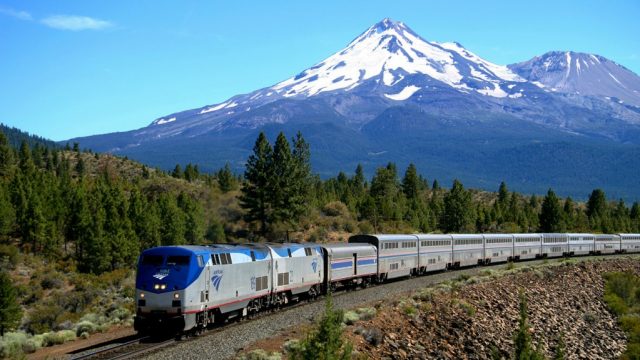The Conservative Case For Amtrak?

“When the talk turns to Amtrak, the arguments often are predictable, with liberals favoring the passenger-train service and conservatives opposing it,” writes Tom Dennis for the Grand Forks Herald today. “But is there a conservative case for Amtrak? There is.”
Amtrak, as I’m sure you all know, has lost billions over the years and continues to exist only because of the taxpayer largesse shoveled toward it by lawmakers. To suggest that there is a conservative case for this kind of wanton waste seems a bit ludicrous.
But according to Dennis, we should support Amtrak and other forms of public transportation because it would reduce overall federal subsidies. The argument is that if more people are riding on trains and buses, etc., etc., then the amount we spend on highway dollars would be reduced. As evidence he cites Moving Minds: Conservatives and Public Transportation, a book by conservatives Paul Weyrich and William Lind.
And their argument seems to boil down to a comparison of all highway spending to all federal transit spending. Which is a little ridiculous. Of course there’s less spending on federal transit than on highways. There are a lot more highways, and those highways move a lot more people.
If you want to do a proper comparison, you can’t just compare the total dollars spent on these two line items in the federal budget. You must compare the subsidy per passenger, and that’s where highways win by a country mile.
[mks_pullquote align=”right” width=”300″ size=”24″ bg_color=”#000000″ txt_color=”#ffffff”]Does anyone really believe Americans want to see their highways downsized in exchange for more subsidized passenger rail service?[/mks_pullquote]
Government spending on highways – federal, state, and local combined – amounts to just pennies per passenger mile traveled and is largely paid for by taxes on gasoline and licensing fees, which amount to use fees for the roads. According to Randall O’Toole, writing for the Foundation for Economic Education, “On a state-by-state basis the subsidies range from 2.6 cents per passenger-mile in Alaska to minus 0.6 cents in Maryland.” Alaska, as you might imagine, is an outlier given the vast and extremely rural nature of the state. Most states in the union see highway spending amounting to less than a penny per passenger mile.
“Eight states in addition to Maryland divert enough money from their gas taxes so that highway users pay more fees than the states actually spend on roads,” writes O’Toole. “At the other end of the scale, seven states and the District of Columbia join Alaska in spending more than a penny per passenger-mile in subsidies to roads. Subsidies in the remaining 32 states are between 0 and 1 cent per passenger-mile.”
He continues, noting that the per-passenger-mile comparison of highways to railroads isn’t flattering. “Rail and transit advocates use the myth of major highway subsidies to justify more subsidies to Amtrak and public transit,” he writes. “Yet according to the Bureau of Transportation Statistics, taxpayers pay at least 21 cents per passenger-mile to subsidize Amtrak.”
This puts lie to the argument that we could somehow diminish highway spending by emphasizing rail travel. That’s clearly not true, given the much higher rate at which rail gobbles up subsidies. Also, consider the practical reality of what the passenger rail enthusiasts are suggesting with their arguments. They seem to believe that we can replace highways, at least to some degree, with passenger rail serve.
Does anyone really think that would happen? Does anyone really believe Americans want to see their highways downsized in exchange for more subsidized passenger rail service?
Give me a break.
North Dakotans should know this better than anyone. The Empire Builder, the Amtrak line which serves our region, is fantastically unprofitable continuing to lose tens of millions of dollars per year even during an uptick in passengers caused by the recent Bakken oil boom. This from a Reuters article published yesterday:
The increase comes from workers like John Dirby, who rides the Empire Builder from his Montana home to North Dakota’s oil fields, where he works as a truck driver, a 10-hour trip. It’s longer than by car but worth it, he says. “I spend tons of time for that job driving already. Why would I want to add on more time behind a wheel?”
But the demand isn’t enough to make it financially viable: the service lost $34.8 million between October and March, more than the same period in the previous fiscal year when it lost $31.9 million.
The Empire Builder, you should know loses about $100 per passenger.
I’d also point out that back in 2011, during the height of the Bakken oil boom, the Empire Builder Line was down for more than a month. You probably didn’t notice. Most people didn’t. Because, despite the claims that Amtrak is some sort of “critical infrastructure,” relatively few people use it.
You cannot call a piece of infrastructure critical if it can go down for more than a month with most citizens not even noticing.
One caveat is that there are some places where passenger rail service is profitable. In the northeast corridor Amtrak’s service is a success story, and that’s great! I’m fine with passenger rail service operating where it is profitable to do so. But in most places in America that’s not the case.
Amtrak should be cut loose from the federal feeding trough. The parts of it that work will survive, and the parts that don’t will cease as a burden on the American taxpayer.




